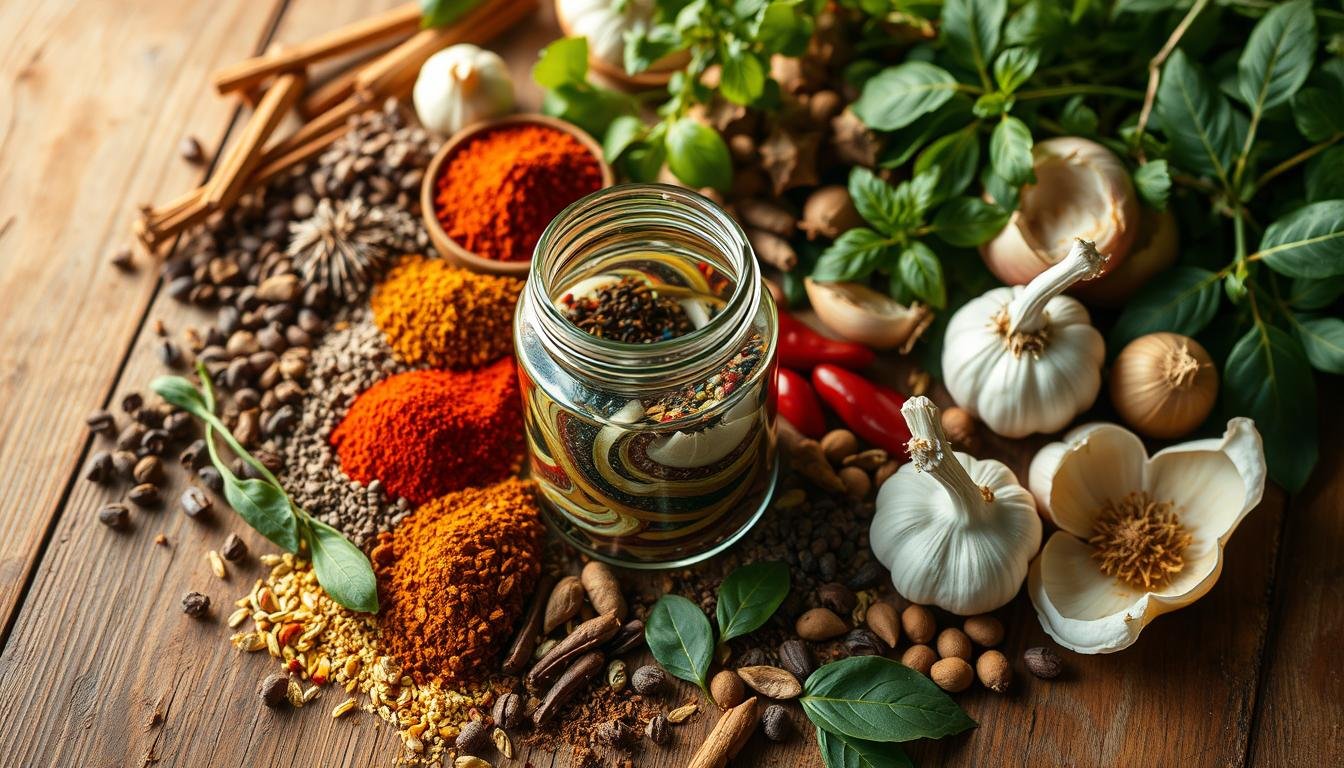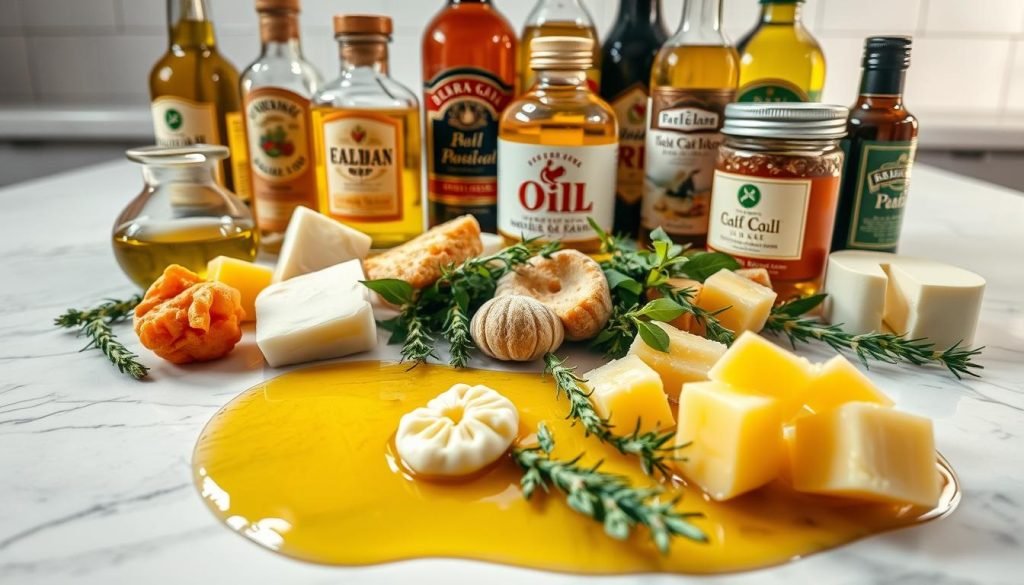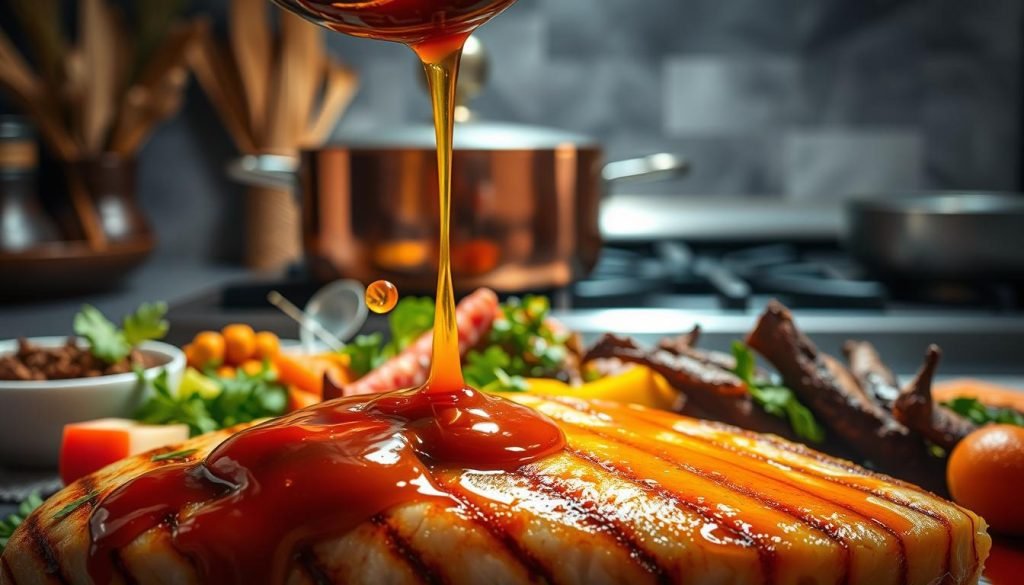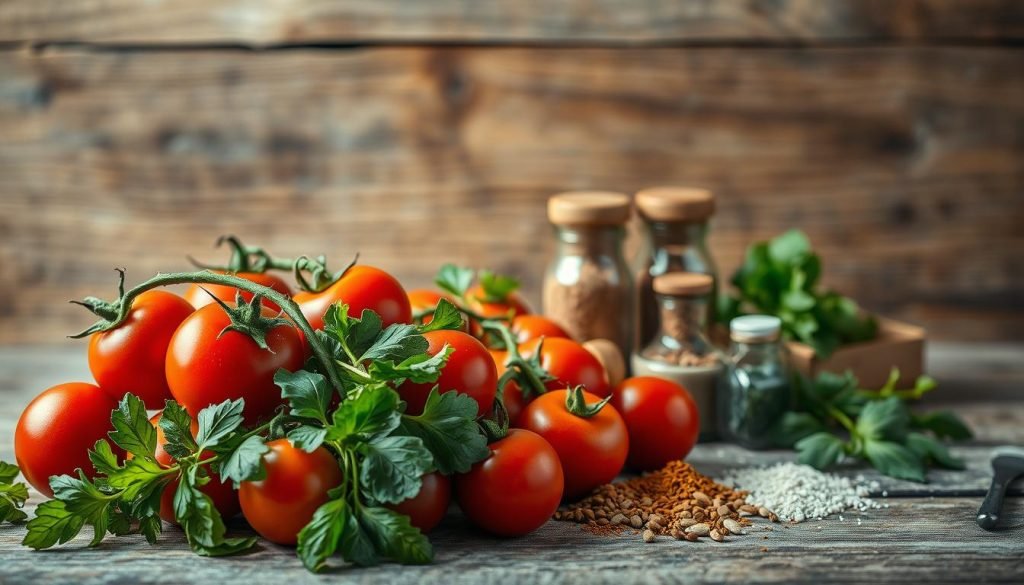Mastering Cooking Flavor Profiles Easily

Ever wondered why some meals sing while others don’t hit the mark? We’re going to explore the exciting world of cooking flavors. You’ll learn how to balance dishes perfectly, no matter your cooking level. Understanding how flavors work together can change how you see food.
Cooking is more than just following a recipe. It’s about mixing flavors and seeing what happens. Once you grasp the basics, you’ll make unforgettable dishes. Picture serving meals that wow your guests. Ready to start this tasty adventure? Let’s begin cooking!
Key Takeaways
- Understanding flavor profiles helps enhance your cooking skills.
- The five basic tastes are Sweet, Salty, Sour, Bitter, and Umami.
- Balance in cooking involves layering and contrasting flavors.
- Ingredients like herbs and spices can dramatically change a dish’s flavor.
- Exploring new flavor combinations can lead to exciting culinary discoveries.
- Flavor harmony techniques improve the overall taste and satisfaction of your dishes.
Understanding the Basics of Flavor Profiles
Hey there! Ever wondered about the magic behind delicious dishes? It’s all in the flavor profiles. Mixing flavors like sweet, salty, sour, bitter, and umami creates memorable meals. We’ll explore these magical flavor profiles and the importance of balance.
What Are Flavor Profiles?
Think of flavor profiles as your dish’s DNA. They blend tastes like sweetness, saltiness, sourness, bitterness, and umami. Each flavor is a note. Together, they play a symphony for the taste buds. For example, Thai food combines sweet, sour, salty, and spicy beautifully. A dish like Tom Yum soup becomes unforgettable.
The Importance of Balance in Cooking
Balance is key in cooking with flavor profiles. It keeps any taste from overpowering others. This harmony makes eating more enjoyable. For instance, adding a bit of salt to caramel sauce can make it taste sweeter. How a food feels, like crunchy vegetables or creamy sauces, also adds to its flavor.
Using seasonal ingredients is important. They often taste stronger and better. They can make your cooking stand out. Adding these ingredients can turn a good dish into a great one.
Here’s a simple table to summarize:
| Flavor Profile Component | Examples | Associated Cuisine |
|---|---|---|
| Sweet | Honey, Maple Syrup | American |
| Salty | Soy Sauce, Anchovies | Asian |
| Sour | Lemon, Vinegar | Mediterranean |
| Bitter | Dark Chocolate, Kale | Global |
| Umami | Mushrooms, Parmesan | Italian |
Learning these basics makes you a better cook and lets you enjoy and try new foods. So, let’s start cooking and have fun with flavor profiles!
The Five Basic Tastes Explained
Understanding *basic tastes* is key to better cooking. Each taste—sweet, sour, salty, bitter, and umami—is vital. They help shape unforgettable dishes.
Sweet: The Flavor of Comfort
Sweetness means energy and comfort. You find it in desserts and some savory dishes. Adding honey to a salad or mixing sweet with spicy can create amazing tastes!
Sour: Brightening Dishes with Acidity
Sour tastes come from things like citrus or vinegar. They make dishes refreshing. Just a lemon squeeze can enhance a meal’s flavor. Mixing spices with sour tastes brings out great flavors.

Salty: Enhancing Natural Flavors
Salt boosts other flavors. It can sweeten, reduce bitterness, and increase umami. Just a little salt can make dishes like roasted veggies or avocado toast taste amazing. Adding salt to spices can highlight your food’s best flavors.
Bitter: The Complex Taste Component
Bitterness is complex but can make dishes interesting. It helps us avoid bad foods. Ingredients like kale, coffee, and dark chocolate are bitter. Mixing bitter with sweet or umami tastes can make delicious, complex flavors.
By using these tastes and trying new spice mixes, you’ll make great dishes. Happy cooking! The power of flavor is yours!
Key Aromatic Ingredients to Explore
Cooking with aroma boosts your dishes from normal to great! Beginner or not, learning their use improves flavors. Here are some top tips to enhance your cooking journey!
Herbs: Fresh vs. Dried
Herbs bring magic to recipes. Fresh herbs like basil give a bright taste. They add 20-30% more flavor than dried ones. Yet, dried herbs like thyme add deep flavors. They’re best in slow-cooked dishes. Usually, use 1 teaspoon dried for every tablespoon fresh. Try both to see what you like!
Spices: Global Flavor Innovations
Global spices offer cooking adventures. Cayenne pepper stars in Mexican hot chocolate. It mixes sweet and spicy well. Asian dishes love turmeric and ginger. Ginger is in 60% of Asian meals. These flavors make eating an exciting journey!
Aromatics: Onions, Garlic, and Beyond
Onions, garlic, and celery are key in many dishes. They’re in 80% of global recipes. Mix like the French mirepoix or the Cajun Holy Trinity for taste. Cooking these in oil or butter for 5-10 minutes releases flavor. It boosts your dish by 30%! Adding these boosts any meal’s taste.
The Role of Fat in Flavor Development
Learning about cooking fats opens a door to great cooking! Fat does more than just add taste. It’s a key ingredient. It brings out the best in each dish, whether it’s butter’s creamy touch or olive oil’s strong flavor. Are you ready to explore fats in cooking?
Types of Cooking Fats
We have many cooking fats in our kitchens. Let’s talk about some common ones:
| Type of Fat | Characteristics | Common Uses | Flavor Profile |
|---|---|---|---|
| Butter | Rich, creamy, melts at low temperatures | Baking, sautéing, sauces | Buttery, rich, slightly sweet |
| Olive Oil | Liquid at room temperature, contains healthy monounsaturated fats | Salad dressings, cooking, marinades | Fruity, robust |
| Coconut Oil | Solid at room temperature, easily melts | Baking, frying, desserts | Tropical, sweet |
| Vegetable Oil | Neutral, high smoke point | Frying, sautéing, baking | Neutral, light |
| Lard | Solid at room temperature, derived from pork fat | Frying, baking | Rich, savory |
Each cooking fat adds its own touch. Picking the right one takes cooking up a notch!
How Fat Enhances Flavor
Fat makes flavors better. It blends them in a special way. Let’s see how:
- Lipids turn into flavor-boosting compounds when cooked.
- Polyunsaturated fatty acids (PUFAs) change flavor when they oxidize.
- The Maillard reaction makes flavors complex and creates a tasty crust.
- Marbling in meat keeps it moist, tender, and full of taste.
Think of a perfectly seared steak. The fat makes the outside crispy and the inside tender. It’s as delicious as it sounds!

Techniques for Layering Flavors
Layering flavors is vital for fantastic dishes. It makes meals go from good to great. This includes building on the five tastes: sweet, spicy, umami, bitter, and salty. Using these wisely can lift your cooking to new heights.

Building Flavor Through Cooking Methods
Searing meat gives it a yummy, brown crust. This adds a rich flavor. Ina Garten uses three main flavors for balance. Think of starting with onions, garlic, and thyme for a tasty base.
Try marinades to boost your dish’s taste. They work great for chicken and shrimp. Also, using fats like sesame oil or butter can greatly improve your dish.
The Importance of Timing
When you add spices and herbs matters a lot. It can change how a dish tastes. But, add fresh herbs later to keep their flavor.
Salt timing is also crucial. Adding it at the end can make flavors pop. Start with root veggies since they take longer to cook. Using a pressure cooker can also help flavors stand out more.
| Technique | Impact on Flavor |
|---|---|
| Sautéing Aromatics | Develops a rich, base flavor foundation |
| Marinating Proteins | Enhances complexity and juiciness |
| Searing | Adds depth through caramelization |
| Layered Timing | Ensures balanced taste profile |
There are many ways to master flavor layering. Your cooking journey is exciting and rewarding. Focus on your methods and timing. And enjoy cooking!
Pairing Ingredients for Maximum Flavor
Pairing ingredients for amazing dishes is fun! Let’s explore classic and new flavor combos. Whether you’re starting or have lots of experience, ingredient flavor matching changes your cooking game!
Classic Flavor Combinations
Some flavors are classics because they’re perfect together. Think tomatoes and basil or peanut butter and jelly. They balance each other, making our taste buds happy. Try these classic combos:
- Sweet and Salty: Caramel with sea salt or watermelon with feta cheese.
- Sour and Sweet: Duck à l’orange or apple pie with lemon touch.
- Bitter and Sweet: Dark chocolate with raspberries or coffee with honey.
Unconventional Pairings to Try
Feeling adventurous? Try unusual pairings for new flavors. Ever had strawberries with basil or chocolate with chili? Here are some surprising combos:
- Fruity: Strawberries with basil or citrus and mint.
- Nutty: Hazelnuts with chocolate or almonds with cherries.
- Spicy: Cinnamon with apples or chili with chocolate.

Cooking with flavor profiles is about finding balance. Sour cuts richness; sweet softens bitterness. Lemon is great with fatty fish. Sea salt makes chocolate amazing. Trying these combinations can elevate a simple dish!
To help you mix flavors, here’s an idea table:
| Flavor Type | Complementary Combo | Example Dishes |
|---|---|---|
| Sweet and Salty | Caramel with sea salt | Sea salt caramel ice cream |
| Sour and Sweet | Duck à l’orange | Duck with orange sauce |
| Bitter and Sweet | Dark chocolate with raspberries | Chocolate raspberry cake |
| Spicy | Cinnamon with apples | Apple cinnamon pie |
| Umami | Soy sauce in marinades | Teriyaki chicken |
So, try mixing these ingredients in your dishes for exciting flavors. Matching flavors and cooking profiles takes practice. But, the journey is very rewarding!
Cultural Influences on Flavor Profiles
It’s amazing how local and global flavors change our cooking! Think about America’s different foods. From Texas barbecue to New England’s seafood, each region has its own taste.

Regional Cuisines of the United States
Each U.S. area offers something special. In the South, you’ll find comfort foods like fried chicken. On the West Coast, the food has Asian and Latin American touches. This mix shows America’s diverse culture.
International Flavors to Incorporate
Love the idea of tasting the world? Adding global flavors to your meals is fun. Imagine using the spices of Indian curries or Japanese miso soup. This brings new tastes and favorites into your kitchen.
Why not try new things from your kitchen? Start with something like soy sauce in stir-fry. Or garam masala in stews. Your taste buds and guests will be happy!
Experimenting with Flavor Profiles
Hey, friend food lovers! Want to improve your cooking? The trick is all in flavor experiments. Start these experiments and write down everything in a Flavor Journal. You’ll soon become a top flavor expert.
Keeping a Flavor Journal
Keeping a Flavor Journal is great for your cooking adventure. It’s a game-changer! Write about your tries with new stuff or ways of cooking. Note what works and what doesn’t. For example, log your try at making a grilled shrimp marinade with citrus juice, achiote paste, cumin, and onion. These notes will help you get better and make dishes just how you like.

Learning Through Tasting
Tasting is key to cooking. It helps us know sweet, salty, sour, bitter, and umami tastes. Taste your food as you cook to see how flavors change. Like adding ras el hanout and pomegranate molasses to a carrot salad. Make sure it tastes perfectly balanced.
For more fun, compare flavors from different parts of the world:
| Cuisine | Key Ingredients |
|---|---|
| Mexican | Citrus juice, achiote, cumin, onion |
| Peruvian | Ají amarillo paste, mango, cumin |
| Mediterranean | Olive oil, garlic, sumac, za’atar |
| Middle Eastern | Cinnamon, turmeric, cumin, coriander |
| Asian | Soy sauce, sriracha, rice wine |
| Indian | Turmeric, cumin, coriander, chili |
So, let’s jump into flavor experiments and taste as we go. Your Flavor Journal is your guide—happy cooking!
Practical Tips for Mastering Flavor Profiles
Getting flavors right is about practice and trusting your taste. It’s a path that requires tweaking recipes to suit you. By embracing this quest, you can make your meals shine with joy and taste. Here are some handy tips to assist you in this flavor-packed journey!
Adjusting Recipes to Your Taste
Changing recipes is key for home cooks. It’s simple to make dishes you’ll love. First, know the five basic tastes: sweet, sour, salty, bitter, and umami. You can use things like lemons, soy sauce, or honey to adjust these tastes. Need more tartness? Try apple cider vinegar. For more umami, miso paste is good. Experimenting with fresh herbs, like basil, and spices, like paprika, enhances your meals.
The Art of Taste Testing
Taste testing does more than just seasoning checks. It teaches how flavors mix. Start by trying your food as you cook. This could mean tasting soup broth before adding salt. Or, adding lime to adjust stir-fry acidity. Focus on flavor levels—high, low, and mid—to boost taste. Smell plays a big part in taste, so use fresh garlic or caramelized onions.
Keep notes of your flavor changes to learn what works. Practicing and trusting your instincts will make you a flavor expert! Each tasting brings you closer to perfect cooking. So keep experimenting, adjusting, tasting, and enjoying your kitchen journey!